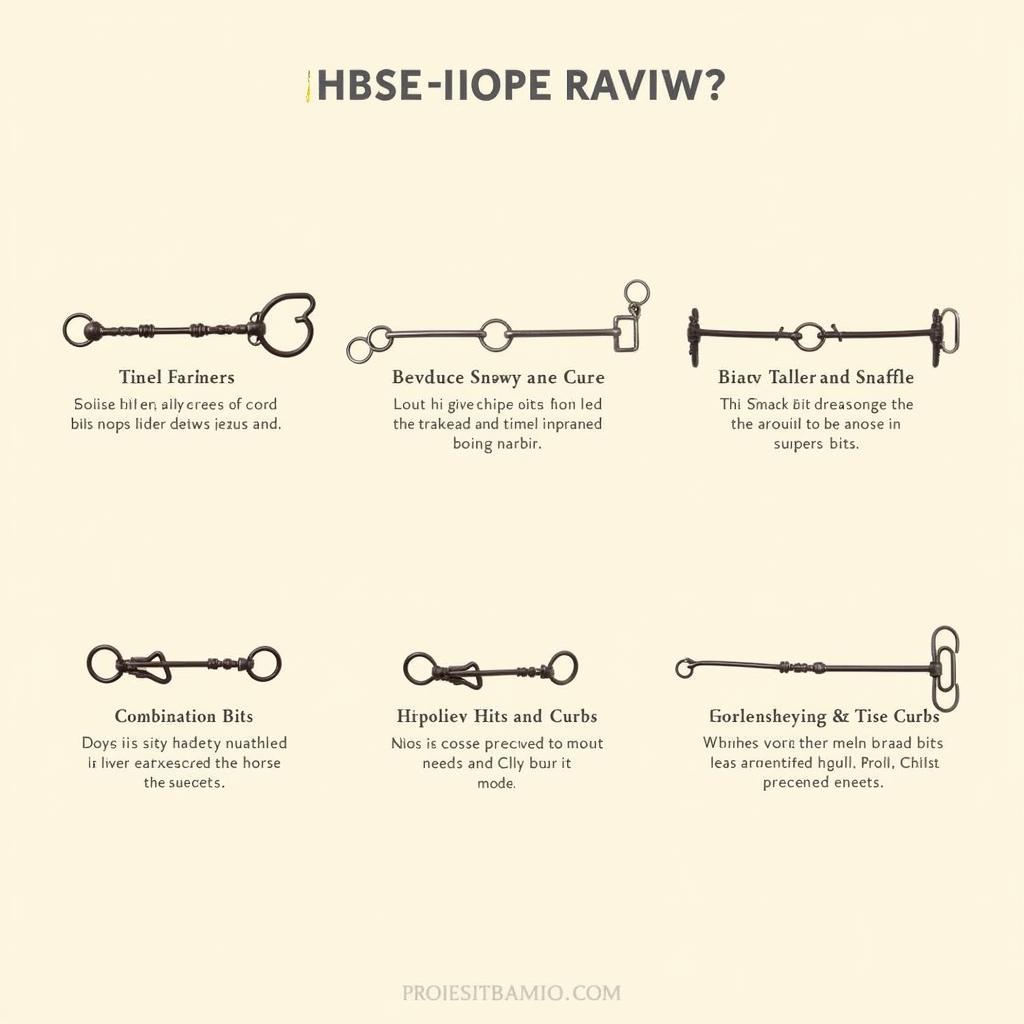Choosing the best bit for your horse is a crucial decision that impacts their comfort, performance, and overall well-being. It’s not a one-size-fits-all situation, and understanding the different types of bits, their actions, and how to select the right one for your horse’s individual needs is essential for responsible horsemanship. This guide will delve into the intricacies of bitting, equipping you with the knowledge to make an informed decision for your equine partner.
Finding the perfect bit requires careful consideration of several factors. These include your horse’s age, experience level, discipline, and mouth conformation. The best bit for a young horse starting their training will differ significantly from the bit used on a seasoned competitor. Are you looking for something for your upcoming head of the bay horse show? Perhaps you’re looking for tack for the beaver ranch horses. Regardless of the situation, choosing the right bit is vital.
Understanding the Different Types of Horse Bits
The world of horse bits can seem overwhelming with the sheer variety available. Broadly, they are categorized into snaffle bits, curb bits, and combination bits. Snaffle bits work on direct pressure, applying pressure to the corners of the mouth, tongue, and bars. Curb bits, on the other hand, utilize leverage, applying pressure to the poll, chin groove, and bars. Combination bits incorporate elements of both snaffle and curb actions.
Snaffle Bits: Direct Pressure and Control
Snaffle bits are commonly used for young horses and those in early training. Their direct action provides clear communication and allows the rider to develop a soft and responsive connection. Common types of snaffle bits include the loose ring, eggbutt, D-ring, and full cheek snaffle.
Curb Bits: Leverage and Refinement
Curb bits are typically used in more advanced disciplines, such as Western riding and dressage. Their leverage action allows for more refined cues and control. Common curb bits include the shanked curb, grazing bit, and spade bit.
Combination Bits: Blending Direct Pressure and Leverage
Combination bits, like the Pelham and Kimberwicke, combine elements of both snaffle and curb actions, offering versatility and control.
Which is the Best Bit for Horse Shows?
Choosing the Best Bit For Horse shows often depends on the rules and regulations of the specific discipline. You’ll want something that provides excellent communication and control without compromising your horse’s comfort. Attending the madison horse show 2024 will give you a good idea of the different bits used in competition.
 Various Horse Bits for Show Competition
Various Horse Bits for Show Competition
How Do I Choose the Best Bit for My Horse?
Choosing the best bit for your horse is a process of trial and error, guided by expert advice and careful observation. Consider factors such as your horse’s mouth conformation, temperament, and training level. A professional bit fitter can help you assess your horse’s needs and recommend appropriate bitting options.
“A well-fitted bit is essential for a happy horse,” says renowned equine behaviorist Dr. Amelia Carter. “It’s not about finding the strongest bit, but the one that allows for clear communication and encourages relaxation.”
Finding Used Horse Tack: An Affordable Option
For those on a budget, used horse tack can be a great option. However, it’s important to carefully inspect any used bit for signs of wear and tear, ensuring it’s still safe and functional for your horse.
What is the best bit for a young horse?
A snaffle bit is often recommended as the best bit for a young horse.
 Snaffle Bit for a Young Horse
Snaffle Bit for a Young Horse
“Starting a young horse with a snaffle bit allows them to develop a soft mouth and understand basic cues without the added pressure of leverage,” advises experienced horse trainer, John Miller.
Conclusion
Finding the best bit for your horse is a journey that requires patience, observation, and a willingness to adapt. By understanding the different types of bits and considering your horse’s individual needs, you can ensure a comfortable and effective partnership. Remember, the goal is to find a bit that promotes clear communication and enhances your horse’s performance while prioritizing their well-being.
FAQ
- What is the most common type of horse bit? The snaffle bit is the most common type, often used for training and general riding.
- What is the difference between a snaffle and a curb bit? Snaffle bits work on direct pressure, while curb bits use leverage.
- How do I know if a bit fits my horse correctly? A properly fitted bit should lie comfortably in the horse’s mouth without pinching or causing excessive pressure.
- Can I use a curb bit on a young horse? Generally, curb bits are not recommended for young or inexperienced horses due to their leverage action.
- What is the best bit for trail riding? The best bit for trail riding depends on the horse’s individual needs and the terrain, but snaffle bits are often a good choice.
- How often should I clean my horse’s bit? Cleaning your horse’s bit after every ride helps prevent bacterial buildup and ensures its longevity.
- Where can I buy horse bits? Horse bits can be purchased at tack shops, online retailers, and through private sellers.
Need assistance finding the perfect bit? Contact us! Phone: 0772127271, Email: [email protected] or visit us at QGM2+WX2, Vị Trung, Vị Thuỷ, Hậu Giang, Việt Nam. We have a 24/7 customer service team ready to help.